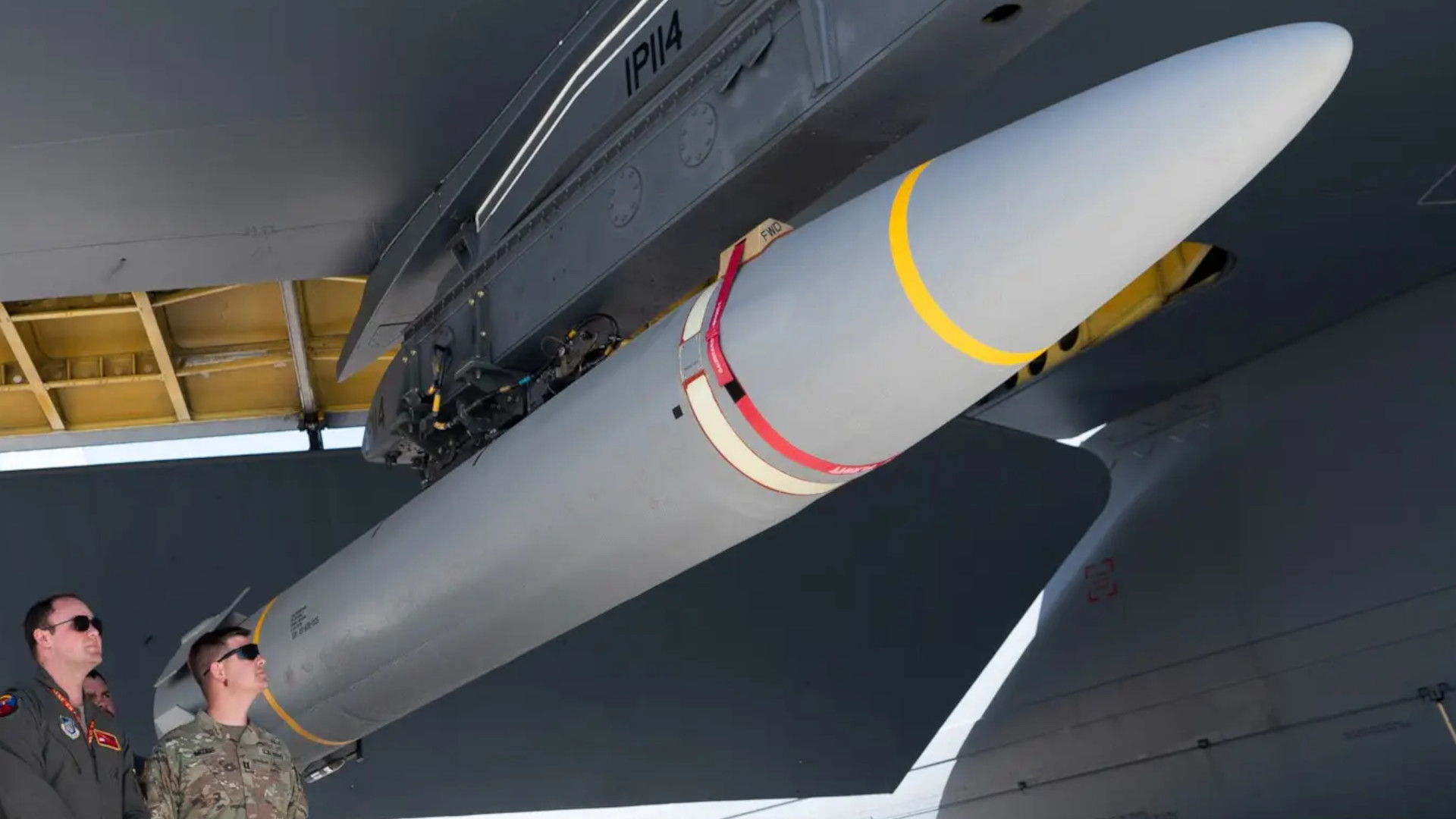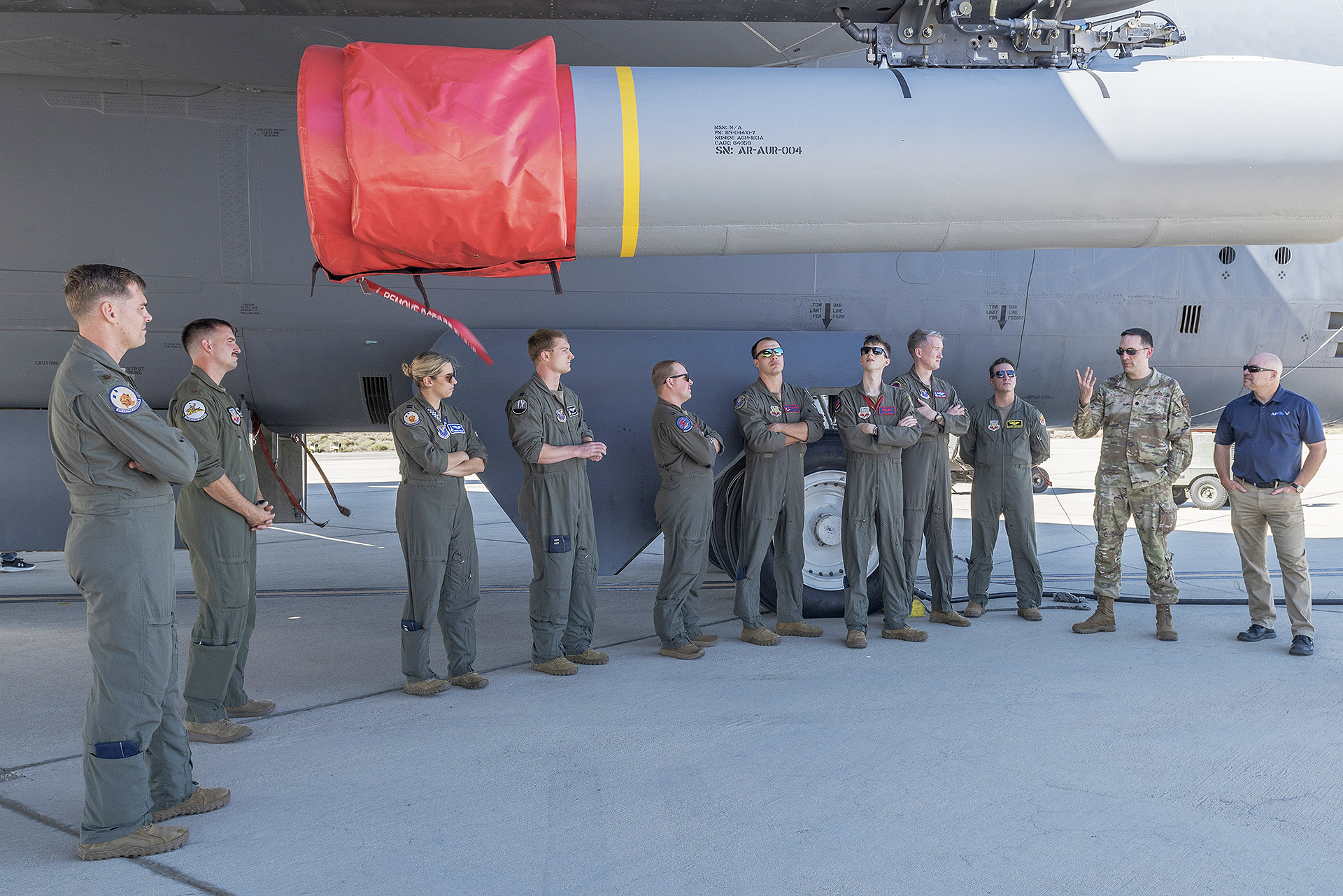Signs are growing that the U.S. Air Force is about to conduct another live-fire test of its AGM-183A Air-launched Rapid Response Weapon hypersonic missile, or ARRW, but this time staged from Guam.
Last week, the service showed off a live AGM-183A under the wing of a B-52H bomber at Andersen Air Force Base on the highly strategic U.S. Pacific island territory, stating it was there for show and tell of sorts with deployed B-52 crews. The event was peculiar and as noted in The War Zone‘s initial reporting on it, a test of the weapon from Guam seemed like a better explanation for it being sent there. This would be a first-of-its-kind show of force, aimed primarily at sending signals to China, and raises questions about the Air Force’s previously stated plans to cancel ARRW.
The Air Force first revealed that it had brought a live AGM-183A to Guam as part of a brief news story about a “hypersonic weapon familiarization training” event at Andersen on February 27. In response to queries from The War Zone last week, the service declined to confirm or deny it had any plans to stage a live-fire ARRW test from the island.

“The Air Force has not conducted a live-fire ARRW missile test recently,” an Air Force spokesperson told The War Zone earlier today.
However, there are clear indications that such a test is imminent.
Observers have noted that publicly available warning notices to aviators and mariners that went into effect over the weekend point to a U.S. test of an air-launched weapon over the Western Pacific sometime this week. The alerts create a path that ends at the Reagan Test Site at Kwajalein Atoll, thousands of miles to the east of Guam, as can be seen in the social media posts below.
The different alert areas would align with how ARRW, which consists primarily of a large rocket booster and unpowered hypersonic boost-glide vehicle on top, functions. The rocket is used to get the entire missile to an optimal altitude and speed, after which the boost-glide vehicle is released. The expended booster and the nose cone then fall away.

Once released, the boost-glide vehicle follows a relatively shallow, atmospheric flight path to its target at hypersonic speeds, defined as anything above Mach 5. The vehicle also has a high degree of maneuverability and has the ability to make multiple course changes along the way and do so erratically. All of this makes the weapon difficult to detect and track, reducing the amount of time defenders have to react and otherwise presenting significant challenges.

The Reagan Test Site is a major U.S. military missile test range that is routinely used to support the testing of very long-range munitions, including hypersonic weapons like ARRW. Portions of the overall test complex on Kwajalein’s Roi-Namur island recently suffered significant damage due to a confluence of factors that produced a surge of enormous waves, as you can read more about here.
Publicly available online flight trackers provide additional evidence of an impending ARRW test. Flight tracking data shows at least two, and possibly three, specially modified High Altitude Observatory (HALO) Gulfstream business jets have been operating from Guam. The HALO aircraft have been used to support ARRW tests in the past.
Various other specialized aircraft and ships are routinely used to collect imagery and other data and otherwise monitor major weapon tests at the Reagan Test Site. There are also a variety of ground-based sensors installed around Kwajalein Atoll. The M/V Pacific Collector, one of the vessels the U.S. military has available to support missile testing, was observed leaving Honolulu, Hawaii on February 24, but its present location is unknown.
In recent years, the U.S. military has been working to significantly improve and expand its hypersonic weapons-focused testing infrastructure, including through the acquisition of modified RQ-4 Global Hawk drones. Those uncrewed aircraft are part of a larger program called Skyrange that you can learn more about here and in the video below.

Given the scope of testing that occurs at the Reagan Test Site, there is the possibility, albeit somewhat remote, that all of this is in support of something other than ARRW test. At the same time, it would be an unusual expenditure of resources to bring one of what is understood to be a very small number of live AGM-183As out to Guam just for a familiarization training engagement. The fact that the exact assets and airspace warnings needed for an ARRW test makes it hard to imagine this is something else. The Air Force also told The War Zone last week that it only has one full end-to-end live-fire ARRW launch left to conduct as part of its currently planned test program.

It has been pointed out that the rough distance between Guam and mainland China is some 1,864 miles (3,000 kilometers) and that, based on the warning notices, the AGM-183A missile and its boost-glide vehicle payload could cover a distance of nearly 1,336 miles (2,150 kilometers) after launch. The B-52H carrying the missile would appear to have to fly thousands of miles east first to a release point, which would also be reflective of a real operational mission.

With all this in mind, it would make sense for the Air Force to use the opportunity of the final end-to-end test to conduct an operationally representative demonstration in a highly strategic part of the world. Andersen Air Force Base on Guam is the Air Force’s main base for staging long-range bomber operations in the Western Pacific and the island is a major hub for the rest of the U.S. military.

Such a test would be the first time, at least that we know of, that the U.S. military has demonstrated a real hypersonic weapon capability in the Western end of the Pacific. It would be an unprecedented show of force in the region that would carry strategic messaging for potential adversaries, particularly China, and allies and partners alike.
By most estimates, U.S. hypersonic weapons are set to be very expensive and only available in small numbers. In turn, the expectation is that they will be reserved for very high-value and heavily defended targets, including major air defense and other command and control nodes. This would be a particularly valuable capability to have in a future high-end conflict, such as one in the Pacific against China.
China’s People’s Liberation Army (PLA) has already fielded at least one hypersonic missile, the land-based DF-17, and is actively working to field a variety of other ground, air, and sea-launched types. Russia has also developed and fielded its own hypersonic missiles, although just how capable they truly are remains a question mark.
U.S. military officials have acknowledged that American efforts in this regard, which also includes the development of land and sea-based hypersonic missiles, have lagged in comparison. An end-to-end ARRW test from Guam would therefore be that much more significant.

All of this raises important questions about the future of ARRW.
“The AGM-183 ARRW is currently in the operational test phase of development,” an Air Force spokesperson told The War Zone last week. “A production decision has not yet been made.”
This is a small, but significant change from how the Air Force phrased its plans for ARRW, which has had a spotty testing record to date, nearly a year ago now. “The Air Force does not currently intend to pursue follow-on procurement of ARRW once the prototyping program concludes,” Andrew Hunter, Assistant Secretary of the Air Force for Acquisition, Technology, and Logistics, said in written testimony submitted for a House Armed Services Committee hearing on March 29, 2023. Despite ARRW’s testing history, this came as something of a surprise at the time, given that this missile had long been touted as being set to be the U.S. military’s first operational hypersonic weapon.

The Air Force’s stated plan at that time was to refocus resources on the separate development of an air-breathing hypersonic cruise missile under the Hypersonic Attack Cruise Missile (HACM) program. There were already signs that the service’s hypersonic priorities were in flux again by the end of last year. In an interview published in December 2023, Assistant Secretary Hunter told DefenseScoop that no particular category of hypersonic weapon had been “ruled out” and that there were “challenges” and “risks” associated with HACM.

The most recent annual report on ARRW from the Pentagon’s Office of the Director of Operational Test and Evaluation, or DOT&E, released earlier this year, also mentioned plans for an “operational demonstration.” DOT&E said the purpose of this would be “to assess the operational capabilities and limitations of the system.”
All this being said, it remains to be seen whether or not the Air Force will actually carry out a live-fire ARRW test from Guam. Even if that is the plan, there is the potential for it to be scrubbed for any number of reasons. As pointed out earlier, the missile has a checkered testing history.
Still, there are mounting indications that ARRW’s future may not be as bleak as it seemed at this same time last year. Signs strongly pointing to an imminent and highly symbolic live-fire end-to-end test of an AGM-183A from a B-52 launched out of Guam only add to the evidence that the missile’s fortunes may be changing, if they haven’t already.
Contact the author: joe@twz.com
